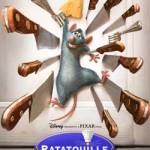Movie Review: WALL•E
WALL•E (2008)–****
 Speaking very positively, I assure you, I called Andrew Stanton’s last Pixar effort, Finding Nemo, “by the book Pixar” with animation that was “just showing off.” Stanton is still showing off with his space odyssey WALL•E, but his robot love story is far from by the book. In fact, for the first hour (and much of the rest of the film), it’s a sci-fi adventure Buster Keaton would have dreamt up.
Speaking very positively, I assure you, I called Andrew Stanton’s last Pixar effort, Finding Nemo, “by the book Pixar” with animation that was “just showing off.” Stanton is still showing off with his space odyssey WALL•E, but his robot love story is far from by the book. In fact, for the first hour (and much of the rest of the film), it’s a sci-fi adventure Buster Keaton would have dreamt up.
That’s the nature of telling a story that is primarily from robots’ point of views. Even after they have developed personalities and quirks all their own, they don’t do much talking. For WALL•E, the last operating clean-up robot on a consumerism ravaged earth, it’s not generally a big deal. He doesn’t have anyone to talk to anyway.
The miniature Johnny 5 sports a trash compactor, creates blocks of junk and stacks them into garbage skyscrapers that tower over the ancient man-made buildings. WALL•E does his job, occasionally interacting with his cockroach pet along the way, and returns to his junk store of a home every night. He pops in his VHS tape of Hello Dolly and learns about love.
With a silent hero, sight gags and fluttering robotic eyes are everything. Stanton and company never falter in engaging the audience with WALL•E’s most endearing qualities—curiosity, klutziness and hopeless romanticism—from the onset. Even before WALL•E has his first encounter with another robot, EVE, we fall for the little guy.
EVE, the femme fatale of explorer bots, makes it to earth aboard an automated shuttle. Her directive? To find life on Earth. After a few attempts to blow away WALL•E, EVE takes a liking to him. He likes her too. When he shows her his prized plant, EVE snags the vegetation, shuts down and waits for her ride. WALL•E, still smitten, tries not to let her get away and hitches a ride into space.
 The first time we see human characters is on the Buy ‘n’ Large Axiom, a luxury spaceliner that has been home to humankind for the last 700 years. If time has made WALL•E more human, it has made these walrus-sized people more slug-like. They stare straight ahead in hover chairs that relieve them of the burden of walking and look only at their holo-screens. Mindless behemoths. Is that our future?
The first time we see human characters is on the Buy ‘n’ Large Axiom, a luxury spaceliner that has been home to humankind for the last 700 years. If time has made WALL•E more human, it has made these walrus-sized people more slug-like. They stare straight ahead in hover chairs that relieve them of the burden of walking and look only at their holo-screens. Mindless behemoths. Is that our future?
Not with WALL•E around. He opens their eyes with a simple helping hand or an accidental interruption of holo-screen gazing. And in the end, isn’t that what WALL•E is about?
Much will likely be said about the film’s green message or its raging against the consumer machine. Yet, WALL•E seems to be self-aware, maybe even self-flattering, enough to grasp a simple concept: The most exciting part of our lives is about finding something great in a world full of garbage and sharing it with someone else.
For the audience, WALL•E is the shiny Zippo lighter in the middle of a mountain of cinematic junk. The silent storytelling. The endearing lead. The visual effects and, dare I use the term for an animated film, the cinematography. Everything about this film aches of freshness. Even its homages to robots of cinema past breathe new life into the robotic characters.
Stanton, who proved with Finding Nemo that he is one of the best animation directors in the business, found a story that worked for him and his animators. We didn’t need talking fish. All we needed was a robot that beeps and squeals to profess his love.
But as WALL•E shows us, there’s little point to finding something great unless we share it with someone else. WALL•E is a film we should share with everyone we know.
WALL•E, directed by Andrew Stanton, is now playing.










